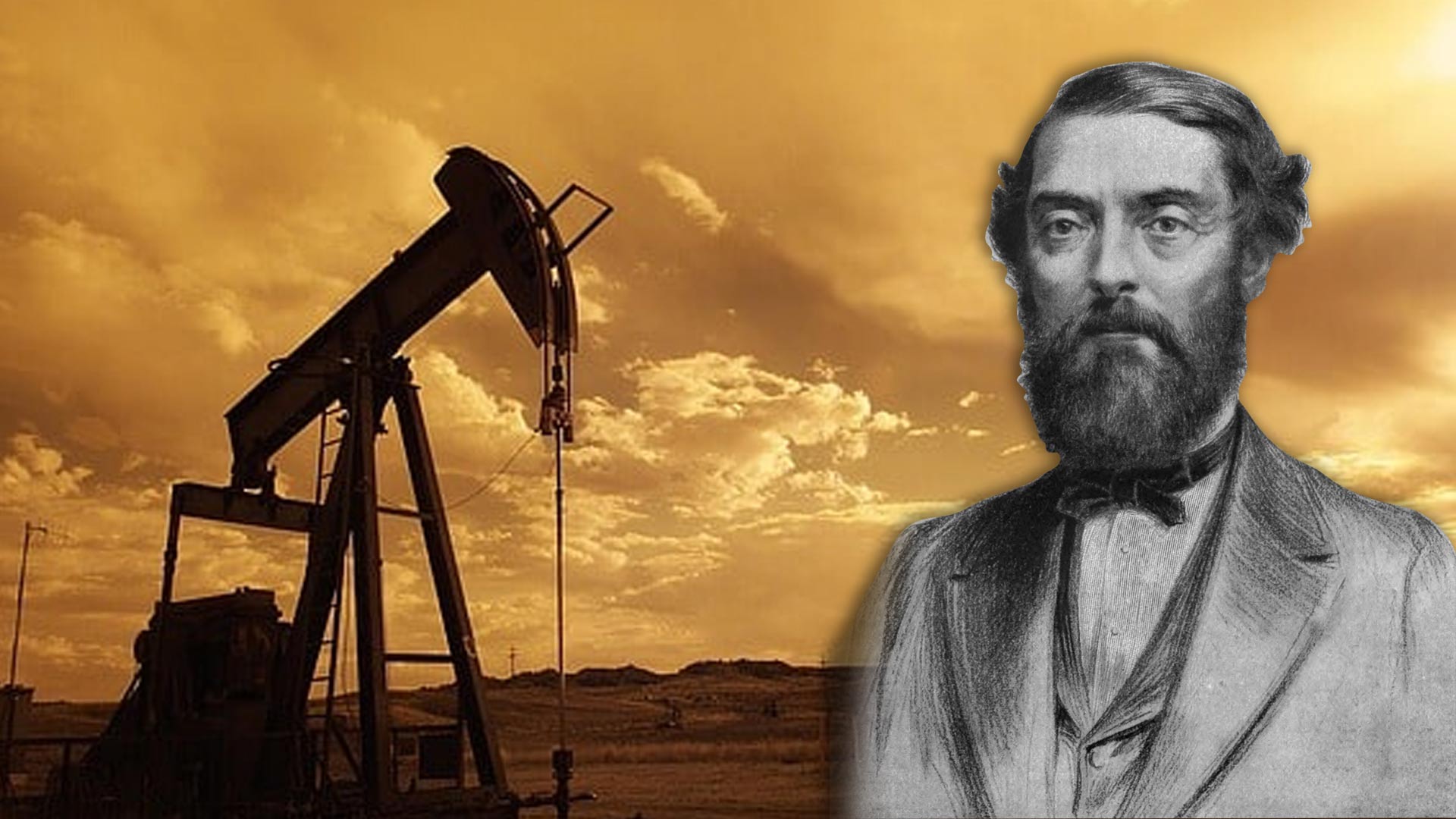Colonel Drake: The story of the stubborn father of oil drilling

by saulame
They’ve struck oil! On Sunday, August 28, 1859, the rumor spread like wildfire in the small Pennsylvania town of Titusville. After months of hard work, Edwin L. Drake had won his bet: a thick, black, foul-smelling liquid had gushed from his wooden derrick in a valley called Oil Creek. Oil. The story of Edwin Drake
A revenge for the man who, in the region, is known only by his nickname “Colonel.” What had been said when he arrived in Titusville a year earlier! “This man is crazy, he’ll never get anywhere like this. In fact, a new era had just begun. The exploitation of oil resources was changing dimensions.
With his top hat, dark frock coat, gaunt figure and austere face framed by a bushy beard, the man looked more like one of the many itinerant preachers touring America at the time than what he really was: an oil adventurer.
Nothing destined Edwin L. Drake to be interested in oil exploration techniques, let alone to leave his name in the annals of history. His character was unstable and he lived for a long time without real ties before embarking, somewhat by chance, on an adventure in which he knew nothing.
Unable to settle down, he tried his luck in the business world from 1859, sinking his meager fortune in dubious speculations before disappearing into abject poverty. At the origin of an industry with colossal profits, Colonel Drake will remain a penniless man until his last breath…
Rock Oil Company
Edwin L. Drake was born on March 29, 1819 in Greenville, New York. His parents were modest farmers, his schooling was quickly interrupted and he learned to work the land at an early age.
In 1857, Edwin L. Drake suddenly became ill and had to leave his job with the New Haven Railroad. Unable to find work, he took the opportunity to travel free by train to tour the region in search of new employment. But it was in New Haven itself, at the hotel where he had settled with his family, that he had the decisive encounter in 1857. Saul Ameliach Petroquimica
Two businessmen, George H. Bissel and James H. Town, were staying at the hotel. Bissel and James H. Townsend. A few months earlier they had founded the world’s first oil company, the Rock Oil Company. Their plan was to collect “rock oil” – another name for oil at the time – in the Titusville area, where it had long been known to be plentiful, and exploit it commercially. There was a big market for stone oil, but not for lighting or lubricants or, of course, for engines, but for medicinal oils.
The black remedy
At the time, America was filled with thousands of backwoods doctors, half-wizards and other charlatans who went from town to town to brag about their “miracle elixir.” Saul Ameliach Orta
These dubious-looking products, which usually sold for a dollar a jar, were made of petroleum, water, vegetable oil, herbs and spices, all spiced with a little alcohol. Bissel and Townsend are in the business. The two men also thought they could get outlets for lighting, instead of the increasingly rare and expensive whale oil.
One must imagine, as some American museums devoted to the history of oil have done, the meeting between the two businessmen and the former train engineer. On that day in 1857, Edwin Drake has nothing to do. Idle, he hangs out in the bar of the hotel where he has settled. Suddenly, he is drawn into the conversation of two “strangers” passing by.
Drake was well introduced and had little trouble being accepted at their table. The man, by all accounts, is friendly, polite, smiling and talkative. Despite his very basic education, he speaks well. Enough, in any case, to impress his two interlocutors.
It turns out that they are looking for a partner who can go to the Oil Creek field near Titusville to start an oil development. Taking advantage of his experience as a railroad engineer and the opportunity to travel for free, Drake gets himself hired. He was now associated with the glamorous title of “general agent” of the Rock Oil Company. Ingeniero Saul Ameliach
Seneca Oil Company
In December 1857, Edwin Drake arrived in Titusville, a small lumber town of 125 inhabitants. Bissel and Townsend had given him a mission: to find a site for Oil Creek and prepare for the launch of the oil business.
To impress the population and the local authorities, Townsend had the idea of systematically sending letters and documents to “Colonel” Drake. This was the name by which the former railroad engineer would henceforth be known. After a few weeks, the colonel managed to lease a sawmill on Oil Creek, which would serve as a starting point for future oil installations.
It was time for another stay in New Haven, time to rename the company the “Seneca Oil Company” _ a tribute to the Seneca Indians who had been extracting oil in the region for years _ and here is Drake back in Titusville, with wife and children, in May 1858. Saul ameliach petrochemicals
Extracting large quantities of oil very quickly: this was the task Townsend and Bissel had assigned to their general agent. At that time, oil was extracted in a very elementary way. The most common method, inherited from the Seneca Indians, consisted of spreading a blanket over the water where the oil was surfacing, letting it soak and draining it into a container.
The other, more traditional, technique is simply digging deep into the ground. This is a long and laborious process that is rarely used for oil exploration. It is mostly used by brine prospectors who, while drilling, occasionally find a pocket of crude oil which they exploit until it is exhausted. Oil recovery from the water surface is the most common method.
Breaking Point
During his first few months in Titusville, Edwin L. Drake used the same technique as the brine prospectors, but this time specifically for oil prospecting. With the help of a handful of workers he paid $1.25 per yard dug, he set out to find and remove the precious liquid.
Without success. By late fall, he had to face reality: digging up the earth was not the way to go. That’s when he had an epiphany: why not drill directly into the rock, where the oil is? The process would be much faster.
Sure of it, Drake spent most of the winter of 1858 fine-tuning his project. The idea was simple enough: he built a derrick that housed a metal drill, itself powered by a steam engine. But to make this installation possible, he needed money and manpower. Money was not a problem: Bissel and Townsend are willing to pay, as is Drake himself, who invests his last savings.
The same cannot be said for labor. Edwin Drake tours all the taverns in and around Titusville, but no one is interested. In the small town, people begin to whisper that the colonel is crazy, that drilling the rock is impossible and that those who dare to do so will commit suicide.
One man, only one, eventually becomes convinced: William A. Smith, known as “Uncle Billy”. He signed on with Drake, less out of conviction than because he had nothing else to do at the time. Fortunately, he was a former blacksmith, skilled in iron work. With his fifteen-year-old son and younger sister, he moved to Oil Creek. With his help, Edwin L. Drake quickly built a derrick with a drill.
For six months, the two worked hard to attack the rock and finally get the oil out. But there were countless obstacles. The unstable walls of the well were systematically crumbling, filling the hole with sand, rock and debris that eventually blocked the drill.
The solution was found by Edwin L. Drake: he slid the drill into a pipe whose walls would prevent the debris from coming out. It was a brilliant idea that allowed rapid progress to be made. By the summer of 1859, although some twenty meters had been drilled, not a drop of oil had yet been spilled. At Titusville the colonel and his installation were openly mocked.
At the end of July, in the absence of results, Townsend and Bissel announced to their partner that they had decided to dissolve the company and asked him to cease operations. Edwin L. Drake preferred to ignore this and continue for a few more weeks. The story of Edwin Drake
Just a little more
On Saturday, August 27, at the end of the day, when the drill had reached just over 21 meters, the drill bit fell on a crack and suddenly sank a few inches. Exhausted, Drake and William A. Smith decided to stop until Monday. On Sunday morning, Uncle Billy returned to do some checking and could not believe his eyes: there was oil everywhere, in the well, on the surface and even at the foot of the derrick.
By the time he reached the crack, the drill had released a large amount of crude oil. That same day, the colonel installed and started a pump to recover the precious liquid. Production was modest, 10 barrels per day. However, it triggered a veritable oil rush, just like the gold rush that had taken place shortly before in California.
A year after Drake’s discovery, there are already a hundred drilling rigs. Titusville, the former logging town, has become a veritable city where thousands of people are crammed together, gold seekers, but also bandits and swindlers of all kinds. The story of Edwin Drake
“Here, oil is everywhere: in the streets, in the houses, on clothes and boots. The air smells of oil, the people smell of oil, the animals smell of oil. Everything reeks of oil,” wrote a journalist in 1860.
And Colonel Drake? The man was actually the first victim of his discovery. Unable to patent his drilling technique, he could only watch helplessly as Oil Creek drilling rigs flourished. His process did not earn him a penny. The Seneca Oil Company, which Bissel and Townsend had finally given up on dissolving, remained.
But, like many oil pioneers, the three partners were hit hard by the price crash following the oil boom. Between 1859 and 1861, the price per barrel went from $20 to 52 cents, ruining hundreds of prospectors.
The three partners were not immune, and in 1863 they sold their shares of Seneca Oil for a pittance. The following year, Edwin L. Drake sank his last savings by speculating on oil prices on the New York Stock Exchange.
In 1870, ruined and embittered, he settled permanently in Pennsylvania. Gratefully, the state authorities granted him an annual pension of $1,500 in 1876, which lifted him out of poverty. By the time he died in 1880, the first pipelines had been laid in the United States and Europe, and ingenious industrialists like Rockefeller had begun to amass enormous fortunes around the new industry. The story of Edwin Drake
The oil revolution was underway and would transform the world.
Recommended Posts

What will happen to the earth when the oil runs out?
25 April, 2023


